The universe is vast and full of wonders, inviting us to gaze upon distant galaxies, shimmering nebulas, and the familiar glow of our moon and planets. For anyone captivated by the cosmos, owning an amateur astronomy telescope opens up an incredible portal to these celestial sights. But with countless options available, finding the perfect telescope can be daunting. This expert-curated guide cuts through the complexity, helping you select an amateur astronomy telescope that suits your budget, skill level, and observing goals.
May brings the Flower Moon on May 12, a sight that only looks better when viewed through one of the best amateur astronomy telescopes. As the month wears on and the full moon dims, there is a great opportunity to see stars of different colors in the night sky. Catch the blue-white stars of the Summer Triangle asterism, orange Arcturus and reddish Antares across the night sky. For fans of the planets, you will need a good amateur astronomy telescope to make the most of Saturn’s pre-dawn appearances this month, even showing up next to the crescent moon on May 22.
There are so many things to consider when buying an amateur astronomy telescope, especially when it is your first. It can be a daunting task, but our guide makes it a breeze. We cover a range of budgets, skill levels and purposes so that you can pick the amateur astronomy telescope that is right for you. Our expert reviewers get hands-on with the models that we recommend, testing out their observational capabilities, ease-of-use and whether they are as good as advertised.
Quick List: Top Amateur Astronomy Telescopes for 2025
Here are some of the best amateur astronomy telescopes we recommend across different categories:
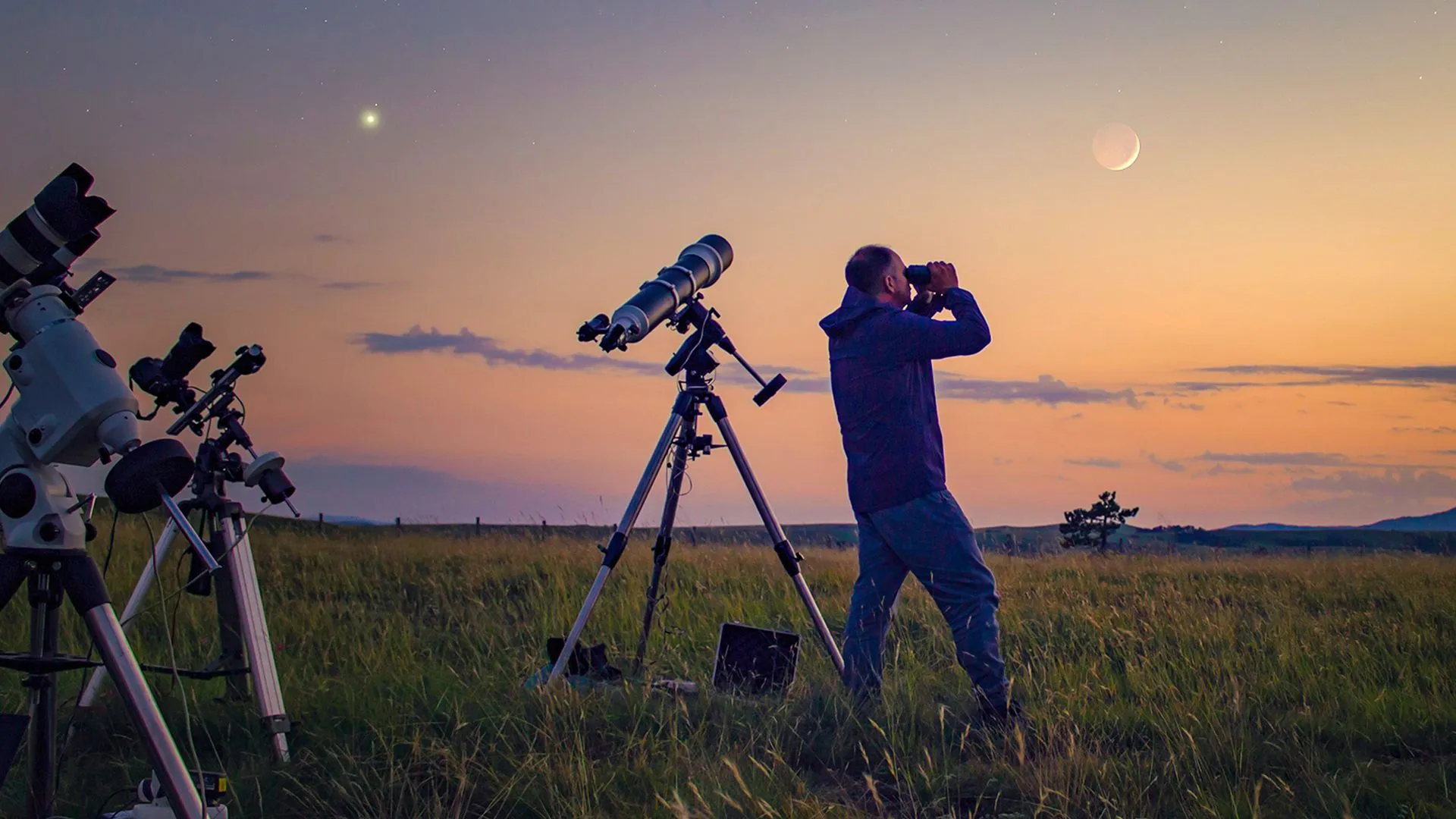 Man uses one of the best amateur astronomy telescopes and binoculars to look at the night sky as the sun sets and telescopes are on tripods around him
Man uses one of the best amateur astronomy telescopes and binoculars to look at the night sky as the sun sets and telescopes are on tripods around him
Best for beginners
A great scope for beginners, the Celestron NexStar 4SE is easy to use and set up, it produces clear and bright images and has a whole host of useful features for amateur astronomy.
Best budget amateur astronomy telescope
The Celestron Inspire 100AZ is a great beginner scope for anyone just getting started with astronomy, it comes with a variety of accessories for amateur astronomy enthusiasts.
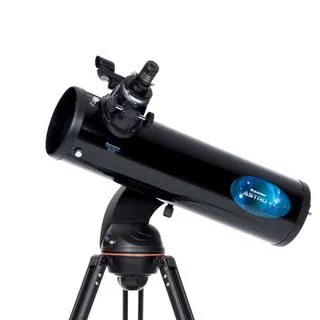 Celestron Astro Fi 130 value amateur astronomy telescope on a white backgroundCelestron Astro Fi 130
Celestron Astro Fi 130 value amateur astronomy telescope on a white backgroundCelestron Astro Fi 130
Best value for enthusiasts
We were really impressed with the Celestron Astro Fi 130 when we reviewed it and found it’s very good value for money as an amateur astronomy telescope.
Best premium amateur astronomy telescope
We think this is an exceptional amateur astronomy telescope that’s easy to set up and offers breath-taking views. It’s suitable for experienced amateur astronomers too.
Best for astrophotography
This smart amateur astronomy telescope takes beautiful deep sky photos in just a few seconds, but it’s not an all-rounder telescope for all observing types.
Best motorized amateur astronomy telescope
A fantastic scope for any experience level, incredibly easy to use yet powerful enough for deep space exploration and even astrophotography for amateur astronomers.
Best for portability
If you live in an urban area with lots of light pollution and need a telescope you can comfortably carry to dark sky sites, this could be the amateur astronomy telescope for you.
Best for accessories
This amateur astronomy telescope is suitable for capturing everything from nebulas to galaxies. It has outstanding optical quality with no signs of distortion, and can accommodate plenty of accessories for amateur astronomy setups.
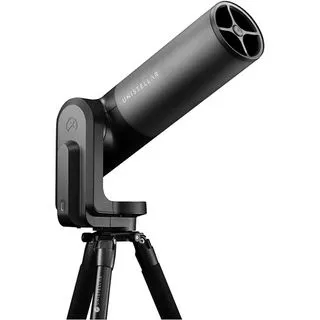 Unistellar eQuinox 2 Smart Amateur Astronomy TelescopeUnistellar Equinox 2
Unistellar eQuinox 2 Smart Amateur Astronomy TelescopeUnistellar Equinox 2
Best smart amateur astronomy telescope
If you’ve got the budget for it, this is Unistellar’s most advanced amateur astronomy telescope to date. It has a very reliable app and features a Smart Light Reduction feature to eliminate light pollution in urban environments.
Best for deep space amateur astronomy
Great for experienced, long-time amateur astronomers, this scope is excellent for astrophotography thanks to the Edge HD technology. It’s a little on the heavy side, but it can carry a load of up to 30 lbs.
Best for kids
This is a great tabletop amateur astronomy telescope and an ideal starting point for beginners and young astronomers. It’s easy to set up and put away, but it’s not the most powerful for advanced viewing.
Best Amateur Astronomy Telescopes 2025 That We Recommend
Our expert reviewers spend hours testing and comparing products and services so you can choose the best amateur astronomy telescope for you.
Best for Beginners
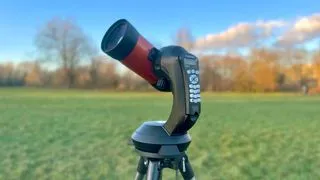 The celestron nexstar 4se beginner amateur astronomy telescope set up outside in a fieldIn our full review of the Nexstar 4SE, we found it was quick and easy to set up, perfect for beginners who want a quality go-to amateur astronomy telescope.
The celestron nexstar 4se beginner amateur astronomy telescope set up outside in a fieldIn our full review of the Nexstar 4SE, we found it was quick and easy to set up, perfect for beginners who want a quality go-to amateur astronomy telescope.
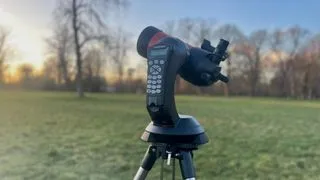 The celestron nexstar 4se beginner amateur astronomy telescope set up outside in a field facing away from the cameraThe Celestron NexStar 4SE’s GoTo technology means you can easily find and track specific celestial objects, making it a good first amateur astronomy telescope.
The celestron nexstar 4se beginner amateur astronomy telescope set up outside in a field facing away from the cameraThe Celestron NexStar 4SE’s GoTo technology means you can easily find and track specific celestial objects, making it a good first amateur astronomy telescope.
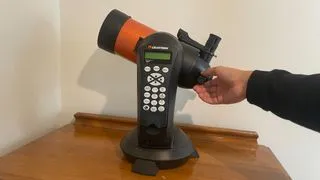 A view of the hand controller for the Celestron NexStar 4SE amateur astronomy telescopeThis scope will fit nicely on your tabletop, a compact option for an amateur astronomy telescope.
A view of the hand controller for the Celestron NexStar 4SE amateur astronomy telescopeThis scope will fit nicely on your tabletop, a compact option for an amateur astronomy telescope.
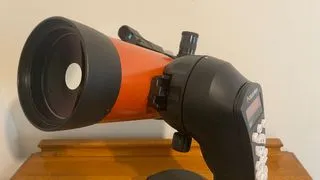 A close up view of the fork arm mount on the Celestron NexStar 4SE amateur astronomy telescopeThe NexStar 4SE features a 4-inch (102mm) aperture and a focal length of 1325mm, suitable for planetary viewing with an amateur astronomy telescope.
A close up view of the fork arm mount on the Celestron NexStar 4SE amateur astronomy telescopeThe NexStar 4SE features a 4-inch (102mm) aperture and a focal length of 1325mm, suitable for planetary viewing with an amateur astronomy telescope.
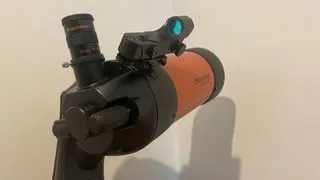 A close up of the finderscope on the Celestron NexStar 4SE amateur astronomy telescopeThe 4SE has a built-in star diagonal operated by a flip mirror at its base, a useful feature on this amateur astronomy telescope.
A close up of the finderscope on the Celestron NexStar 4SE amateur astronomy telescopeThe 4SE has a built-in star diagonal operated by a flip mirror at its base, a useful feature on this amateur astronomy telescope.
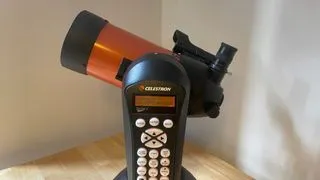 A side view of the Celestron NexStar 4SE amateur astronomy telescope on a wooden tableCelestron’s orange tube design is definitely an eye-catcher for an amateur astronomy telescope.
A side view of the Celestron NexStar 4SE amateur astronomy telescope on a wooden tableCelestron’s orange tube design is definitely an eye-catcher for an amateur astronomy telescope.
 Author operating the Celestron 4SE amateur astronomy telescope in the back yardSetting up the Celestron 4SE is a cinch, but despite the small tube, transporting this amateur astronomy telescope was cumbersome when on foot.
Author operating the Celestron 4SE amateur astronomy telescope in the back yardSetting up the Celestron 4SE is a cinch, but despite the small tube, transporting this amateur astronomy telescope was cumbersome when on foot.
Celestron NexStar 4SE
Best for finding planets: It can find celestial objects easily with Celestron’s SkyAlign technology, making it an excellent introductory amateur astronomy telescope.
Our expert review:
Specifications
Optical design: Maksutov-Cassegrain
Mount type: Computerized Alt-Azimuth
Aperture: 4-inches / 102mm
Focal length: 1325mm
Highest useful magnification: 241x
Lowest useful magnification: 15x
Supplied eyepieces: 25mm
Weight: 23 lbs (10.44kg) fully assembled
Reasons to buy
- Uncomplicated, quick setup
- Auto finds night sky objects
- High quality, sturdy build
- No collimation required
Reasons to avoid
- Narrow field of view
- Not very portable
- Limited accessories supplied
Buy it if
✅ It’s your first amateur astronomy telescope: This scope is easy to use and set up, making it perfect for beginner astronomers.
✅ You want GoTo technology: You can easily find and track specific celestial objects with little or no prior knowledge using this amateur astronomy telescope.
Don’t buy it if:
❌ You want to travel with it: This amateur astronomy telescope isn’t the most portable as the tripod doesn’t fold down entirely.
The bottom line:
🔎 Celestron NexStar 4SE: If you want to view the planets and bright objects in the sky quickly and effortlessly, the Celestron NexStar 4SE will certainly do the job as an amateur astronomy telescope. ★★★★
| Attributes | Notes |
|---|---|
| Design | Solid and sturdy build, signature orange colors. |
| Performance | Great for observing the moon and planets for amateur astronomy. |
| Functionality | Alignment correction can be tricky. |
Best Budget Telescope
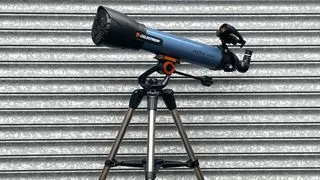 A side profile view of the Celestron Inspire 100AZ budget amateur astronomy telescope against a corrugated iron backdropThe Celestron Inspire 100AZ comes with a plethora of helpful accessories for amateur astronomy, but after our full review, we’d recommend updating the eyepieces.
A side profile view of the Celestron Inspire 100AZ budget amateur astronomy telescope against a corrugated iron backdropThe Celestron Inspire 100AZ comes with a plethora of helpful accessories for amateur astronomy, but after our full review, we’d recommend updating the eyepieces.
 A close-up of the focusing knob on the Celestron Inspire 100AZ budget amateur astronomy telescope tubeThis amateur astronomy telescope is easy to set up and use, even for beginners.
A close-up of the focusing knob on the Celestron Inspire 100AZ budget amateur astronomy telescope tubeThis amateur astronomy telescope is easy to set up and use, even for beginners.
 A red flashlight that slots into the tripod of the Celestron Inspire 100AZ budget amateur astronomy telescopeA small red flashlight slots in to illuminate the accessory tray, a thoughtful addition for an amateur astronomy telescope user.
A red flashlight that slots into the tripod of the Celestron Inspire 100AZ budget amateur astronomy telescopeA small red flashlight slots in to illuminate the accessory tray, a thoughtful addition for an amateur astronomy telescope user.
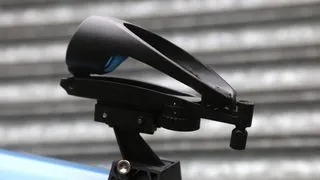 The finderscope attached to the Celestron Inspire 100AZ budget amateur astronomy telescopeA StarPointer Pro finderscope features a bullseye and sits close to the eyepiece on this amateur astronomy telescope.
The finderscope attached to the Celestron Inspire 100AZ budget amateur astronomy telescopeA StarPointer Pro finderscope features a bullseye and sits close to the eyepiece on this amateur astronomy telescope.
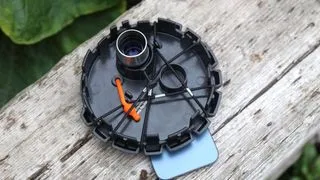 The eyepiece and dust cap together from the Celestron Inspire 100AZ budget amateur astronomy telescopeA smartphone straps to one side using elasticated cords while an eyepiece fits in the other, showing the versatility for amateur astronomy.
The eyepiece and dust cap together from the Celestron Inspire 100AZ budget amateur astronomy telescopeA smartphone straps to one side using elasticated cords while an eyepiece fits in the other, showing the versatility for amateur astronomy.
 Showing the smartphone holder in action with the Celestron Inspire 100AZ budget amateur astronomy telescopeA smartphone straps to one side using elasticated cords while an eyepiece fits in the other, demonstrating a feature useful for beginner astrophotography with this amateur astronomy telescope.
Showing the smartphone holder in action with the Celestron Inspire 100AZ budget amateur astronomy telescopeA smartphone straps to one side using elasticated cords while an eyepiece fits in the other, demonstrating a feature useful for beginner astrophotography with this amateur astronomy telescope.
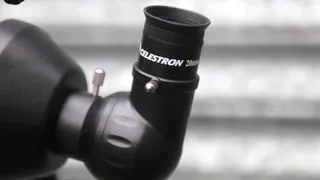 The side profile of the star diagonal on the Celestron Inspire 100AZ budget amateur astronomy telescopeThe Celestron Inspire 100AZ comes with 20 mm and 10 mm Kellner eyepieces, standard for an amateur astronomy telescope kit.
The side profile of the star diagonal on the Celestron Inspire 100AZ budget amateur astronomy telescopeThe Celestron Inspire 100AZ comes with 20 mm and 10 mm Kellner eyepieces, standard for an amateur astronomy telescope kit.
Celestron Inspire 100AZ Refractor
Best budget amateur astronomy telescope for budding skywatchers who want to get up and running quickly.
Our expert review:
Specifications
Optical design: Refractor
Mount type: Alt-azimuth
Aperture: 3.94-inches / 100mm
Focal length: 660mm
Highest useful magnification: 241x
Lowest useful magnification: 15x
Supplied eyepieces: 10mm, 25mm
Weight: 20 lbs (9.07kg)
Reasons to buy
- Sharp views of planets and the moon
- Handy smartphone adaptor for amateur astronomy photos
- Built-in red light
- Lightweight frame
Reasons to avoid
- Bearings lack precision
- Some chromatic aberration
- No solar observing possible
Buy it if
✅ You’re a beginner: We found it easy to set up and take down, perfect for beginner amateur astronomy telescope users.
✅ You want to take astro shots on your smartphone: The lens cap cleverly turns into a smartphone holder so you can capture images of the night sky with this amateur astronomy telescope.
Don’t buy it if:
❌ You aren’t confident locating objects yourself: This amateur astronomy telescope doesn’t have GoTo technology, so you’ll need to be able to locate specific celestial objects yourself (or with the help of a stargazing app).
❌ You want detailed views of deep sky objects: While this amateur astronomy telescope can give great views of planets and the moon, objects further away may appear a little underwhelming.
The bottom line
🔎 Celestron Inspire 100az: Aimed at beginners and those looking to upgrade, this 4-inch refractor performs best with the moon and planets. It comes with a lens cap that converts to a smartphone holder for easy astrophotography, making it a solid amateur astronomy telescope. ★★★★
| Attributes | Notes |
|---|---|
| Design | Fairly lightweight, good for an amateur astronomy telescope. |
| Performance | Excels with lunar views. |
| Functionality | Easy to set up and take down, suitable for amateur astronomy. |
Best Value for Enthusiasts
 The Celestron Astro Fi 130 enthusiast amateur astronomy telescope on a white backgroundThe Celestron Astro Fi 130’s wide field of view will allow you to see large galaxies without having to reposition the telescope often, a great feature for an amateur astronomy telescope.
The Celestron Astro Fi 130 enthusiast amateur astronomy telescope on a white backgroundThe Celestron Astro Fi 130’s wide field of view will allow you to see large galaxies without having to reposition the telescope often, a great feature for an amateur astronomy telescope.
Celestron Astro Fi 130
Best value enthusiast amateur astronomy telescope: A guide to the night sky, packed with technology at a low price.
Our expert review:
Specifications
Optical design: Newtonian Reflector
Mount type: Computerized altitude-azimuth single fork
Aperture: 5.19-inches / 130mm
Focal length: 650mm
Highest useful magnification: 307x
Lowest useful magnification: 19x
Supplied eyepieces: 25mm and 10mm
Weight: 18 lbs (8.6kg)
Reasons to buy
- Suitable for low budgets
- Great entry-level amateur astronomy telescope
- Vixen dovetail for mount changes
- Portable
- Computer recommends targets
- Finds targets at touch of button
Reasons to avoid
- Eyepieces limit observations
- Focuser of low quality
- Battery drains quickly
- Useless without app
Buy it if
✅ You want a beginner-friendly, grab & go, easy-to-use amateur astronomy telescope: We thought this was a great entry-level telescope that can find targets at the touch of a button and is great for on-the-go observations.
Don’t buy it if:
❌ You want a ‘traditional’ telescope: We found this amateur astronomy telescope is completely useless without the app, so if you want a more traditional telescope without much of the newer technology, look elsewhere.
The bottom line
🔎 Celestron Astro Fi 130: A good amateur astronomy telescope at an exceptionally good price, it has everything you’d need if you’re just starting out, although we would recommend upgrading some of the pieces included. It can lose charge quickly in cold conditions, though, so consider buying an additional power source. ★★★½
| Attributes | Notes |
|---|---|
| Design | Very sturdy build with well constructed tube and tripod for an amateur astronomy telescope. |
| Performance | Makes use of SkyAlign technology for easy alignment. |
| Functionality | Great for lunar and planetary observing, but some views are fuzzy. |
Best Premium
 The Celestron NexStar Evolution 9.25 premium amateur astronomy telescope on a tripod on a white backgroundAutomatically track objects as they move across the sky with this high-quality Catadioptric amateur astronomy telescope.
The Celestron NexStar Evolution 9.25 premium amateur astronomy telescope on a tripod on a white backgroundAutomatically track objects as they move across the sky with this high-quality Catadioptric amateur astronomy telescope.
Celestron NexStar Evolution 9.25
Best GoTo scope for seeing the universe in HD, but it has a premium price point for an amateur astronomy telescope.
Our expert review:
Specifications
Optical design: Schmidt-Cassegrain
Mount type: Computerized alt-azimuth fork arm
Aperture: 9.25-inches / 235mm
Focal length: 2350mm
Highest useful magnification: 555x
Lowest useful magnification: 34x
Supplied eyepieces: 13mm, 40mm
Weight: 62.60 lbs (28.39kg)
Reasons to buy
- Crisp views with no defects
- Easy to set up
- High-quality design
Reasons to avoid
- Isn’t very portable — best for backyard star gazing for amateur astronomy
- Expensive
Buy it if
✅ You want to view a wide range of subjects: This amateur astronomy telescope has a large aperture which enables clear and detailed views of a wide range of celestial objects, including planets, deep-sky objects and nebulas.
✅ You’re an experienced skywatcher: Although its easy setup is a dream for beginners, this scope is best suited for more advanced, passionate amateur astronomers who want a full view of the universe.
Don’t buy it if:
❌ You want something portable: Portability isn’t one of the Evolution 9.25’s strengths, so it’s best used for backyard gazing with an amateur astronomy telescope.
The bottom line
🔎 Celestron NexStar Evolution 9.25: A fantastic amateur astronomy telescope best suited to experienced skywatchers, with a price tag to match its premium features. It’s not the easiest to transport, but we think it’s one of the best GoTo telescopes you can buy. ★★★★½
| Attributes | Notes |
|---|---|
| Design | A bit bulky and tricky to transport for an amateur astronomy telescope. |
| Performance | Crisp views with no defects. |
| Functionality | Motorized mount a good choice for astrophotography for amateur astronomers. |
Best for Astrophotography
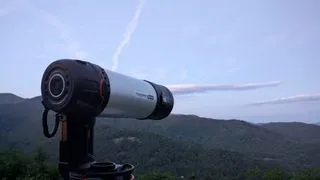 A black and white Celestron Origin amateur astronomy telescope in a fieldThe Celestron Origin looks like a classic Celestron optical tube, minus an eyepiece, designed for amateur astronomy imaging.
A black and white Celestron Origin amateur astronomy telescope in a fieldThe Celestron Origin looks like a classic Celestron optical tube, minus an eyepiece, designed for amateur astronomy imaging.
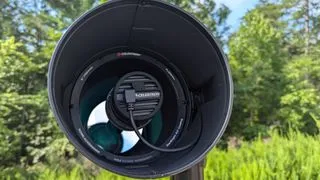 A black and white Celestron Origin amateur astronomy telescope in a field with trees behind it, ready for astrophotographyThe camera inside the Celestron Origin enables you to capture beautiful shots of the night sky, perfect for amateur astronomy astrophotography.
A black and white Celestron Origin amateur astronomy telescope in a field with trees behind it, ready for astrophotographyThe camera inside the Celestron Origin enables you to capture beautiful shots of the night sky, perfect for amateur astronomy astrophotography.
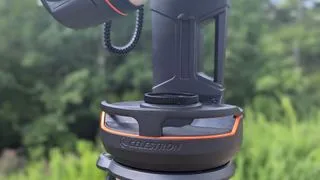 A black and white Celestron Origin amateur astronomy telescope in a field with trees behind it, showing handles for transportThere are several handles on the Origin’s mount to make carrying it easier, important for transporting an amateur astronomy telescope.
A black and white Celestron Origin amateur astronomy telescope in a field with trees behind it, showing handles for transportThere are several handles on the Origin’s mount to make carrying it easier, important for transporting an amateur astronomy telescope.
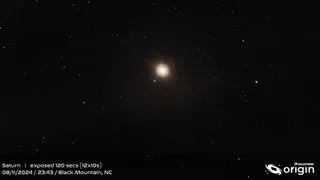 A black and white Celestron Origin amateur astronomy telescope in a field with trees behind it, used for observing SaturnThe Celestron Origin enabled us to view Saturn, although we struggled with focusing on planets with this amateur astronomy telescope.
A black and white Celestron Origin amateur astronomy telescope in a field with trees behind it, used for observing SaturnThe Celestron Origin enabled us to view Saturn, although we struggled with focusing on planets with this amateur astronomy telescope.
 An example of a sharp astro shot taken without a filter with the Celestron Origin amateur astronomy telescope. The subject is the Crescent Nebula (NGC 6888).An example of a sharp astro shot taken without a filter with the Celestron Origin, showcasing its capability as an amateur astronomy telescope for deep sky imaging.
An example of a sharp astro shot taken without a filter with the Celestron Origin amateur astronomy telescope. The subject is the Crescent Nebula (NGC 6888).An example of a sharp astro shot taken without a filter with the Celestron Origin, showcasing its capability as an amateur astronomy telescope for deep sky imaging.
Celestron Origin Intelligent Home Observatory
Best for astrophotography: This smart amateur astronomy telescope can take clear photos of deep sky objects in seconds.
Our expert review:
Specifications
Optical design: Rowe-Ackermann Schmidt Astrograph (RASA)
Mount type: Motorized Alt-azimuth
Aperture: 6-inches / 152mm
Focal length: 335mm
Highest useful magnification: N/A
Lowest useful magnification: N/A
Supplied eyepieces: N/A
Weight: 41.6 lbs (18.6 kg)
Reasons to buy
- Crystal clear deep sky photos in seconds for amateur astronomy
- Quick set up
- Easy-to-use, helpful app
- Stacks and processes images automatically
Reasons to avoid
- Not ideal for all celestial objects
- Quite large and heavy
Buy it if
✅ You want an automated telescope: Focusing, tracking, finding targets and stacking processed images is all automatic with this amateur astronomy telescope.
✅ You want to take deep sky images: The Origin can do this and more in just a few minutes, with little pre-knowledge required for amateur astronomy.
Don’t buy it if:
❌ You want a traditional telescope: This one doesn’t have an eyepiece and only gives you views of the night sky on a mobile device, different from a standard amateur astronomy telescope.
❌ You’re on a budget: At around $4,000, this amateur astronomy telescope is on the pricier side.
The bottom line
🔎 Celestron Origin Intelligent Home Observatory: This (pricey) smart amateur astronomy telescope can do every part of stargazing autonomously, and produces beautiful photos of the night sky in seconds. ★★★★½
| Attributes | Notes |
|---|---|
| Design | Bulky, but full of useful features on the mount for amateur astronomy. |
| Performance | Beautiful, clear photos of deep sky objects. |
| Functionality | Motorized mount, but not a traditional amateur astronomy telescope with an eyepiece. |
Best Motorized Telescope
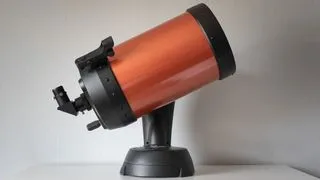 Celestron NexStar 8SE motorized amateur astronomy telescope review photo showing clutter-free sidesThe clutter free sides make the 8SE easy to manouver without breaking any ‘bits’ off, practical for a motorized amateur astronomy telescope.
Celestron NexStar 8SE motorized amateur astronomy telescope review photo showing clutter-free sidesThe clutter free sides make the 8SE easy to manouver without breaking any ‘bits’ off, practical for a motorized amateur astronomy telescope.
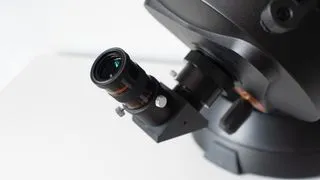 Celestron NexStar 8SE motorized amateur astronomy telescope review photo showing the 25mm eyepieceThe NexStar 8SE comes with a 25mm eyepiece. You’d probably want to invest in a 10mm eyepiece for a closer look at celestial objects with this amateur astronomy telescope.
Celestron NexStar 8SE motorized amateur astronomy telescope review photo showing the 25mm eyepieceThe NexStar 8SE comes with a 25mm eyepiece. You’d probably want to invest in a 10mm eyepiece for a closer look at celestial objects with this amateur astronomy telescope.
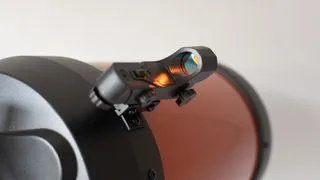 Celestron NexStar 8SE motorized amateur astronomy telescope review photo showing the finderscopeAlthough the included NexStar 8SE finderscope looks very basic, it’s actually surprisingly effective for locating targets with this amateur astronomy telescope.
Celestron NexStar 8SE motorized amateur astronomy telescope review photo showing the finderscopeAlthough the included NexStar 8SE finderscope looks very basic, it’s actually surprisingly effective for locating targets with this amateur astronomy telescope.
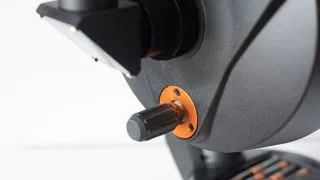 Celestron NexStar 8SE motorized amateur astronomy telescope review photo showing the focus knobThe focus knob is large. It can easily be found in the dark and can be operated when wearing gloves, a convenient feature on this amateur astronomy telescope.
Celestron NexStar 8SE motorized amateur astronomy telescope review photo showing the focus knobThe focus knob is large. It can easily be found in the dark and can be operated when wearing gloves, a convenient feature on this amateur astronomy telescope.
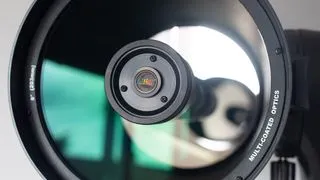 Celestron NexStar 8SE motorized amateur astronomy telescope review photo showing the large aperture lensThe NexStar 8SE has a 203.2mm aperture lens which means you can observe deep-sky objects with breathtaking detail and vividness using this amateur astronomy telescope.
Celestron NexStar 8SE motorized amateur astronomy telescope review photo showing the large aperture lensThe NexStar 8SE has a 203.2mm aperture lens which means you can observe deep-sky objects with breathtaking detail and vividness using this amateur astronomy telescope.
 Celestron NexStar 8SE motorized amateur astronomy telescope review photo showing controlsThe controls on the NexStar 8SE are easy to use, even for beginners using a motorized amateur astronomy telescope.
Celestron NexStar 8SE motorized amateur astronomy telescope review photo showing controlsThe controls on the NexStar 8SE are easy to use, even for beginners using a motorized amateur astronomy telescope.
 Celestron NexStar 8SE motorized amateur astronomy telescope review photo showing the hand controllerThe Celestron NexStar 8SE is controlled by an in-built hand controller rather than an app, a classic approach for an amateur astronomy telescope.
Celestron NexStar 8SE motorized amateur astronomy telescope review photo showing the hand controllerThe Celestron NexStar 8SE is controlled by an in-built hand controller rather than an app, a classic approach for an amateur astronomy telescope.
Celestron NexStar 8SE
Best motorized amateur astronomy telescope: Ideal for astrophotography and deep space observing, giving excellent image clarity and detail.
Our expert review:
Specifications
Optical design: Schmidt-Cassegrain
Mount type: Computerized alt-azimuth fork arm
Aperture: 8-inches / 203mm
Focal length: 2032mm
Highest useful magnification: 480x
Lowest useful magnification: 29x
Supplied eyepieces: 25mm
Weight: 32 lbs (14.48kg)
Reasons to buy
- Incredibly bright views for amateur astronomy
- Sharpness across the entire field of view
- Pricey, but good value for money
Reasons to avoid
- Will price some beginners out
- Slewing using the remote is a little laggy, but not much
Buy it if
✅ You’re looking for a long-term telescope: There’s no question that this amateur astronomy telescope is pricey, but it’s one that will last you for decades — it’s not called ‘The World’s Most Beloved Telescope’ for nothing among amateur astronomers.
✅ You want to use it for astrophotography: Thanks to the smooth and accurate tracking, this scope is a great option for taking stunning astro images of deep sky objects for amateur astronomy.
Don’t buy it if:
❌ You’re on a budget: Although this is definitely worth the money and we’d recommend it if your budget can stretch to it, it is very pricey. If you’re on a budget or you’re new to the medium, there are plenty of cheaper alternatives that will be more than good enough for amateur astronomy.
The bottom line
🔎 Celestron NexStar 8SE: An outstanding amateur astronomy telescope with incredible optics that would suit a beginner, intermediate or advanced astronomer. It’s great for astrophotography and gives beautifully bright and detailed views. Our only fault with it is that it can price out beginners. ★★★★½
| Attributes | Notes |
|---|---|
| Design | Can be transported as a fully-assembled setup, convenient for an amateur astronomy telescope. |
| Performance | Outstanding optics, slightly tricky to align if you’re not used to it. |
| Functionality | Easy to assemble and disassemble. |
Best for Portability
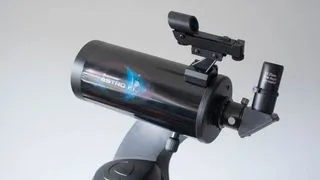 The Celestron Astro Fi 102 portable amateur astronomy telescopeThe telescope may not be the most attractive, and some might even say it looks a little ‘toyish,’ but the optical quality is good for an amateur astronomy telescope.
The Celestron Astro Fi 102 portable amateur astronomy telescopeThe telescope may not be the most attractive, and some might even say it looks a little ‘toyish,’ but the optical quality is good for an amateur astronomy telescope.
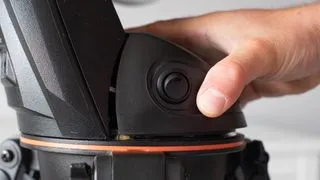 The Celestron Astro Fi 102 portable amateur astronomy telescope showing the finishWhile this amateur astronomy telescope is very portable, we found the finish doesn’t feel very premium.
The Celestron Astro Fi 102 portable amateur astronomy telescope showing the finishWhile this amateur astronomy telescope is very portable, we found the finish doesn’t feel very premium.
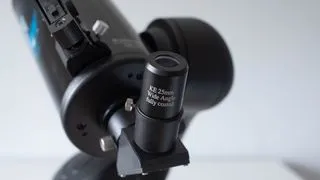 The Celestron Astro Fi 102 portable amateur astronomy telescope with eyepiecesThe telescope comes with a 25 mm eyepiece and a 10mm eyepiece providing 53x and 132.5x magnification respectively, suitable for amateur astronomy observations.
The Celestron Astro Fi 102 portable amateur astronomy telescope with eyepiecesThe telescope comes with a 25 mm eyepiece and a 10mm eyepiece providing 53x and 132.5x magnification respectively, suitable for amateur astronomy observations.
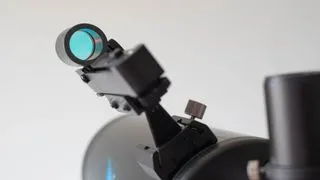 The finderscope attached to the Celestron Astro Fi 102 portable amateur astronomy telescopeThe finderscope is attached to the tube with ease on this amateur astronomy telescope.
The finderscope attached to the Celestron Astro Fi 102 portable amateur astronomy telescopeThe finderscope is attached to the tube with ease on this amateur astronomy telescope.
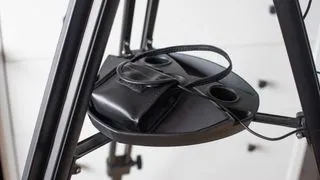 The accessory tray of the Celestron Astro Fi 102 portable amateur astronomy telescopeThe accessory tray is useful for keeping your gear nearby and tidy in the dark, a practical feature for an amateur astronomy telescope user.
The accessory tray of the Celestron Astro Fi 102 portable amateur astronomy telescopeThe accessory tray is useful for keeping your gear nearby and tidy in the dark, a practical feature for an amateur astronomy telescope user.
 The battery pack of the Celestron Astro Fi 102 portable amateur astronomy telescopeThe battery pack requires 8 AA batteries. We’d like it if the cable connection was a little more robust on this amateur astronomy telescope.
The battery pack of the Celestron Astro Fi 102 portable amateur astronomy telescopeThe battery pack requires 8 AA batteries. We’d like it if the cable connection was a little more robust on this amateur astronomy telescope.
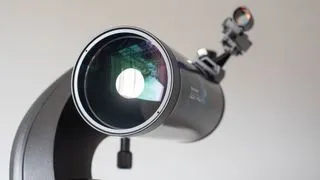 The side profile of the Celestron Astro Fi 102 portable amateur astronomy telescope optical tube assemblyThe optical tube assembly is 38.1cm long and 11.7cm in diameter, contributing to the portability of this amateur astronomy telescope.
The side profile of the Celestron Astro Fi 102 portable amateur astronomy telescope optical tube assemblyThe optical tube assembly is 38.1cm long and 11.7cm in diameter, contributing to the portability of this amateur astronomy telescope.
Celestron Astro Fi 102
Best lightweight and portable go-to mount scope for beginner sky watchers, a great amateur astronomy telescope option.
Our expert review:
Specifications
Optical design: Maksutov-Cassegrain
Mount type: Computerized Alt-Azimuth Single Fork Arm
Aperture: 4.0-inches / 102mm
Focal length: 1325mm
Highest useful magnification: Up to 100x with digital zoom
Lowest useful magnification: 15x
Supplied eyepieces: 25mm and 10mm
Weight: 6 lbs (2.7kg)
Reasons to buy
- Very portable thanks to its lightweight design for amateur astronomy
- Reasonably and fairly priced
- No prior experience needed
Reasons to avoid
- Optics could be better
- Tripod isn’t the best quality
- Doesn’t feel like a premium product to the touch
Buy it if
✅ You’ll be traveling with it: This scope is our top choice for portability, so it’s ideal if you plan on taking it away on camping trips or to areas with darker skies with your amateur astronomy telescope.✅ You’re a beginner: If you just want to look at the moon and some planets, this is a great amateur astronomy telescope choice.
Don’t buy it if:
❌ You want good quality parts: This amateur astronomy telescope has an element of ‘you get what you pay for’. It’s adequate for basic astronomy, but the tripod isn’t the best quality, the optics could be better and it didn’t have a premium feel.
The bottom line
🔎 Celestron Astro Fi 102: Best suited for viewing the moon and planets, this amateur astronomy telescope is great for beginners and anyone with no prior experience. It can be a little tricky to setup initially, and it’s not the best quality scope we’ve reviewed, but it’ll do the job. ★★★½
| Attributes | Notes |
|---|---|
| Design | Highly transportable, but tripod needs weighing down, typical for a lightweight amateur astronomy telescope. |
| Performance | Initial setup can be tricky, but after that it’s a breeze. |
| Functionality | Large database of celestial objects on SkyPortal, useful for amateur astronomy navigation. |
Best for Accessories
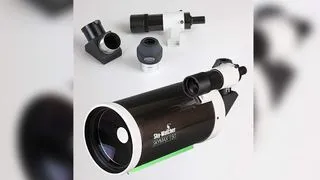 The Sky-Watcher Skymax 150 PRO amateur astronomy telescope and accessories laid on a white tableThis amateur astronomy telescope is a great astrophotography all-rounder; you can capture everything from planets to deep-sky subjects.
The Sky-Watcher Skymax 150 PRO amateur astronomy telescope and accessories laid on a white tableThis amateur astronomy telescope is a great astrophotography all-rounder; you can capture everything from planets to deep-sky subjects.
Sky-Watcher Skymax 150 PRO
Best for accessories: The Skymax 150 PRO can accommodate CCD or DSLR cameras, filter wheels and other add-ons for advanced amateur astronomy setups.
Our expert review:
Specifications
Optical design: Maksutov-Cassegrain
Mount type: Equatorial (EQ-5 Pro)
Aperture: 5.90-inches / 150mm
Focal length: 1800mm
Highest useful magnification: 450x
Lowest useful magnification: 36x
Supplied eyepieces: 28 mm
Weight: 13.23 lbs (6kg)
Reasons to buy
- High-quality, lightweight build
- Excellent optics
- Great for a wide selection of astrophotography for amateur astronomy
Reasons to avoid
- Not all models come with a tripod
- Comes with only one eyepiece
Buy it if
✅ You want to travel with it: Most astrophotography involves traveling to dark sky sites, and this amateur astronomy telescope is light enough to do just that.
✅ Your primary focus is astrophotography: We recommend this amateur astronomy telescope as the best for astrophotography thanks to its amazing optics.
Don’t buy it if:
❌ You’re looking for something super sophisticated: For those looking for high-end, sophisticated instruments and have the money to spend on them, a smart telescope would likely be a better fit than this amateur astronomy telescope.
The bottom line
🔎 Sky-Watcher Skymax 150 PRO: This amateur astronomy telescope is perfect for astrophotographers who want to take it on shoots — it has great quality optics and an excellent build. It can accommodate plenty of accessories, although not all models come with a tripod. ★★★★
| Attributes | Notes |
|---|---|
| Design | High quality build, excellent optics, suitable for amateur astronomy. |
| Performance | Outstanding optics, with no sign of distortion. |
| Functionality | Great for a wide selection of astrophotography for amateur astronomy. |
Best Smart Telescope
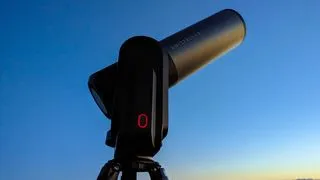 Unistellar eQuinox 2 smart amateur astronomy telescope in-use against night skyThe Unistellar eQuinox 2 can smoothly and silently slew to night sky objects and image them within minutes of getting it out of the box, simplifying amateur astronomy.
Unistellar eQuinox 2 smart amateur astronomy telescope in-use against night skyThe Unistellar eQuinox 2 can smoothly and silently slew to night sky objects and image them within minutes of getting it out of the box, simplifying amateur astronomy.
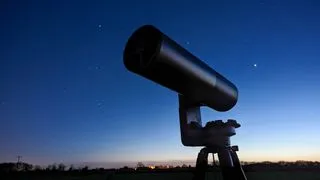 Unistellar eQuinox 2 smart amateur astronomy telescope in-use against starry skyOnly a single button appears on the eQuinox 2 telescope, the power button which glows red when on and connected, typical for a smart amateur astronomy telescope.
Unistellar eQuinox 2 smart amateur astronomy telescope in-use against starry skyOnly a single button appears on the eQuinox 2 telescope, the power button which glows red when on and connected, typical for a smart amateur astronomy telescope.
 Screenshots of the Unistellar app in use with the eQuinox 2 smart amateur astronomy telescopeAll of the functionality of this amateur astronomy telescope can be accessed with the accompanying app.
Screenshots of the Unistellar app in use with the eQuinox 2 smart amateur astronomy telescopeAll of the functionality of this amateur astronomy telescope can be accessed with the accompanying app.
Unistellar eQuinox 2 telescope
Best smart amateur astronomy telescope: This smart telescope offers simple astronomy powered by a clever smartphone app.
Our expert review:
Specifications
Optical design: Newtonian Reflector
Mount type: Motorized GoTo alt-azimuth
Aperture: 4.49-inches / 114mm
Focal length: 450mm
Highest useful magnification: 400x digital
Lowest useful magnification: 50x optical
Supplied eyepieces: N/A
Weight: 19.8 lbs (9kg)
Reasons to buy
- Beautiful, simple layout and design
- Get views of the night sky fast for amateur astronomy
- App is easy to operate
Reasons to avoid
- Image resolution is average
- Can’t orientate telescope in twilight
- Laggy views when focusing
Buy it if
✅ You live in an urban area: This scope has a Smart Light Pollution Reduction feature that removes light pollution, so it’s a great option if you don’t live near a dark sky site for amateur astronomy.
✅ You want simplicity: This is an incredibly sleek, all-in-one amateur astronomy telescope that has no need for additional accessories and can take you to your chosen celestial objects with ease.
Don’t buy it if:
❌ You’re on a budget: Unsurprisingly, this amateur astronomy telescope is an expensive bit of kit, so it’ll price out most beginners and anyone who doesn’t have a big budget.
The bottom line
🔎 Unistellar eQuinox 2: An easy-to-use motorized smart amateur astronomy telescope that can locate night sky objects at the push of a button, the eQuinox 2 can have you exploring the stars in minutes without the need for prior knowledge, although its in-built camera isn’t quite detailed enough. ★★★★½
| Attributes | Notes |
|---|---|
| Design | Slim, sleek, neat package for an amateur astronomy telescope. |
| Performance | Quick go to location of night sky objects. |
| Functionality | Doesn’t orientate until well after twilight, easy once oriented. |
Best for Deep Space
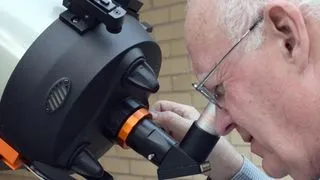 Review photo of the Celestron Advanced VX8 Edge HD deep space amateur astronomy telescopeThe Celestron Advanced VX8 comes packaged with Celestron’s imager focused Advanced VX mount, suitable for deep space amateur astronomy.
Review photo of the Celestron Advanced VX8 Edge HD deep space amateur astronomy telescopeThe Celestron Advanced VX8 comes packaged with Celestron’s imager focused Advanced VX mount, suitable for deep space amateur astronomy.
 Review photo of the Celestron Advanced VX8 Edge HD deep space amateur astronomy telescope showing the mountComputerized mount finds celestial objects, taking commands from hand box or via USB from your PC, enhancing deep space amateur astronomy.
Review photo of the Celestron Advanced VX8 Edge HD deep space amateur astronomy telescope showing the mountComputerized mount finds celestial objects, taking commands from hand box or via USB from your PC, enhancing deep space amateur astronomy.
 Review photo of the Celestron Advanced VX8 Edge HD deep space amateur astronomy telescope with camera attachmentAn astrocamera (not included) or DSLR attaches in place of the eyepiece for photography through the telescope, facilitating deep space amateur astronomy imaging.
Review photo of the Celestron Advanced VX8 Edge HD deep space amateur astronomy telescope with camera attachmentAn astrocamera (not included) or DSLR attaches in place of the eyepiece for photography through the telescope, facilitating deep space amateur astronomy imaging.
 Review photo of the Celestron Advanced VX8 Edge HD deep space amateur astronomy telescope mountAdvanced VX mount (older version shown, with aftermarket saddle) can carry camera and telephoto lens for dramatic deep-sky images in amateur astronomy.
Review photo of the Celestron Advanced VX8 Edge HD deep space amateur astronomy telescope mountAdvanced VX mount (older version shown, with aftermarket saddle) can carry camera and telephoto lens for dramatic deep-sky images in amateur astronomy.
Celestron Advanced VX 8 EdgeHD
Best for pinpoint sharpness across the whole field of view, this is one for veteran amateur astronomers looking for a capable amateur astronomy telescope.
Our expert review:
Specifications
Optical design: Schmidt-Cassegrain
Mount type: Motorized equatorial
Aperture: 8-inches / 203.2mm
Focal length: 2032mm
Highest useful magnification: 480x
Lowest useful magnification: 29x
Supplied eyepieces: 40mm
Weight: 61 lbs (27.67kg)
Reasons to buy
- EdgeHD has the best optics available in an amateur astronomy telescope of this size
- Computerized mount finds and tracks objects reliably
- Dovetail mount system
- Proven design on the market for years, incrementally refined for amateur astronomy
Reasons to avoid
- Setting up requires some knowledge of the sky
- Only one eyepiece is supplied
- Needs a sturdier mount for serious long-exposure photography
Buy it if
✅ You want to see everything: While some telescopes are only good for seeing the moon and planets or deep space, this amateur astronomy telescope is good for seeing all types of celestial objects.
✅ You want a seamless experience: We found the motorized mount on this amateur astronomy telescope very smooth and slick.
Don’t buy it if:
❌ You’re a beginner: This amateur astronomy telescope is intended for those with experience and knowledge of the sky and telescopes, so if you’re just starting out, we’d suggest a more beginner-friendly model.
❌ You want something lightweight: At 61 lbs (27.67kg), this amateur astronomy telescope is heavier than most other choices in this guide.
The bottom line
🔎 Celestron Advanced VX 8 EdgeHD: Intended for serious amateurs, this optically excellent amateur astronomy telescope is suitable for all types of visual astronomy with its rugged, lightweight computerized mount. If you know the sky and plan to be doing astronomy for a long time, this is the amateur astronomy telescope to get. ★★★★½
| Attributes | Notes |
|---|---|
| Design | EdgeHD optical design outperforms Schmidt-Cassegrain. |
| Performance | Finds and tracks celestial objects reliably, great for amateur astronomy. |
| Functionality | Great views of all types of celestial objects. |
Best for Kids
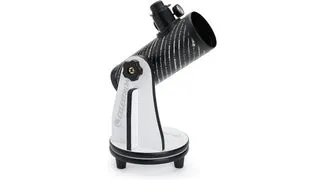 Celestron FirstScope 76mm tabletop amateur astronomy telescope on a white backgroundThe Celestron FirstScope is a low-budget tabletop instrument to instill some sky-watching enthusiasm into your children, acting as their first amateur astronomy telescope.
Celestron FirstScope 76mm tabletop amateur astronomy telescope on a white backgroundThe Celestron FirstScope is a low-budget tabletop instrument to instill some sky-watching enthusiasm into your children, acting as their first amateur astronomy telescope.
Celestron FirstScope 76 Tabletop telescope
Best tabletop amateur astronomy telescope suited to on-the-go astronomers with small hands.
Our expert review:
Specifications
Optical design: Reflector
Mount type: Dobsonian
Aperture: 2.99-inch / 76mm
Focal length: 11.81-inch / 300mm
Highest useful magnification: 180x
Lowest useful magnification: 11x
Supplied eyepieces: 4mm, 20mm
Weight: 4.5 lbs / 2.04kg
Reasons to buy
- Portable
- Easy to use
- Robust build
- Low investment for casual or young amateur astronomers
- Fast focal ratio for easy observations of wide-angle targets
Reasons to avoid
- Loose focuser
- Some observations lack clarity and detail
- A challenge to collimate
- Finderscope not supplied
Buy it if
✅ You want low investment: For casual viewing, this amateur astronomy telescope is a great option with a low price point.
✅ You don’t want to spend ages setting it up: It arrives assembled and ready to go, so no complicated setup process needed for this amateur astronomy telescope.
Don’t buy it if:
❌ You want to find objects easily: It doesn’t come with a finderscope, so anyone wanting to locate certain celestial objects easily with their amateur astronomy telescope may get frustrated.
❌ You want all the extras: This package doesn’t include a finderscope, so you’ll need to either buy one separately or consider another amateur astronomy telescope package that does.
The bottom line
🔎 Celestron FirstScope 76 Tabletop Telescope: If you have children who have been bugging you for a telescope and you can’t quite commit to a moderately-priced instrument, then the FirstScope may be for you — especially if the moon and casual glances at the night sky are of interest for amateur astronomy. ★★★★
| Attributes | Notes |
|---|---|
| Design | Good quality build for the price, suitable for an amateur astronomy telescope for kids. |
| Performance | Provides a ‘wow factor’ for young observers. |
| Functionality | Optics struggle to pick out detail. |
Essential FAQs for Choosing Your Amateur Astronomy Telescope
Finding the right amateur astronomy telescope involves understanding some key concepts and knowing what questions to ask.
How to Choose the Right Amateur Astronomy Telescope?
Choosing the perfect amateur astronomy telescope can be a serious challenge, especially as a beginner. There’s a lot of jargon and technical knowledge that surrounds them. Plus, you’ve got hundreds of options to choose from, with multitudes of different configurations, settings, all at a wide range of prices.
The good news is that quality of telescopes has drastically improved in recent years, so most models’ quality is usually pretty good these days; you’re unlikely to end up with a total dud. That said, there are better options than others, and we’ve endeavored to only include the very best amateur astronomy telescopes in this guide.
The most important factor in choosing an amateur astronomy telescope is the optical quality it provides. You’ll also want to think about what aperture you need and whether you need a more portable model or a larger, more powerful one. Beginner telescopes are a brilliant option if you’re just starting out in the field of amateur astronomy.
In order to get the best possible views of the night sky, you’ll also need to consider where you’re observing from, what objects you’d like to see in particular, your setup if you’re going to attempt astrophotography, and more. If you’re planning on roaming with your amateur astronomy telescope, weight and portability are other factors to take into consideration.
We’d strongly advise you to stick to reputable telescope dealers to buy your scope from. That way you’ll be sure to get exactly what you’ve ordered, and many will provide a warranty with your purchase. Astronomical equipment businesses also tend to offer the best deals on their products, and have advisors on hand to help you make the right decision for your amateur astronomy telescope.
Below, you’ll find a breakdown of the different types of telescopes you can buy, as well as which model we think is best.
Understanding Different Types of Amateur Astronomy Telescopes
There are three main types of amateur astronomy telescopes: reflector, refractor and catadioptric telescopes.
Reflectors have a main mirror to gather and focus light, whereas refractors have an objective lens. Catadioptrics have a main mirror, and a lens of the same diameter. All three of these types of telescopes have ‘sub-types’ which vary by design. For example, the most basic reflector telescopes have a Newtonian design, which means they have a main mirror and a smaller, secondary one to divert the light at right angles to the eyepiece from the top of the telescope.
As we’ve mentioned above, nowadays, you’re spoilt for choice when it comes to quality (and relatively affordable!) amateur astronomy telescopes. So, which type should you opt for? We think Newtonian reflector telescopes on a simple undriven alt-azimuth mount (known as a ‘Dobsonian’) offer the best value in terms of aperture for amateur astronomy.
However, if you are interested in learning your way around the night sky ‘the old fashioned way’, then a Dobsonian telescope might be the way to go. They don’t come with any bells and whistles, so you’ll need to arm yourself with a star map to make sense of stargazing with this type of amateur astronomy telescope. Dobsonians collect a lot of light, and they have enough resolving power to deliver breathtaking views of celestial objects. Dobsonian telescopes over 6 inches in aperture tend to be pretty large and imposing, so you’ll need to consider where it can be stored if you purchase one for your amateur astronomy setup. A garden shed or garage might be the best option.
If you add an equatorial or computerized mount, Newtonian or refractor telescopes become much more expensive. You can find several types of computerized mounts for Newtonian amateur astronomy telescopes: Dobsonians (push-to or GoTo), single time-mounted (tracking or GoTo) and German equatorial (GoTo). For reference, for a computerized push-to Dobsonian, you’ll be looking at spending about twice as much than for a manual model of the same aperture, while a GoTo will set you back almost four times the price of its manual counterpart. A premium Newtonian on a German equatorial mount can be as much as ten times more expensive than one on a manual mount for amateur astronomy!
If ease of use, portability and convenience are high on your requirements, and you like gadgets, then a short focal length refractor of up to 4 inches or a catadioptric (Schmidt- or Maksutov-Cassegrain) up to 5 inches on a computerized mount may well fit the bill as an amateur astronomy telescope. These are versatile telescopes with high magnification which enables you to observe amazing details on the moon and planets.
Achromatic refractors with short focal lengths typically display a degree of false color around the edges of bright objects like the moon because they can’t focus all wavelengths of light to a precise point. Most users are happy to accept this drawback because refractors are so easy to use and care for; however, if you’re after a clean, high-contrast view without false color, the Maksutov is the best option here for an amateur astronomy telescope.
The best views of the night sky are obtained through apochromatic refractors. Using special glass objectives, they focus all wavelengths of light to as near a single point as possible and are free of false color. It is worth noting though that apochromats cost around four times as much as equivalent-sized achromats, making them a more significant investment for an amateur astronomy telescope. It’s up to you whether you’re prepared to invest that kind of money into your skywatching.
 The Celestron AstroMaster 102AZ refractor amateur astronomy telescope and accessories on a white backgroundRefractors are usually supplied with a simple alt-azimuth mount that allows you to slew from left to right and up and down, common for a beginner amateur astronomy telescope.
The Celestron AstroMaster 102AZ refractor amateur astronomy telescope and accessories on a white backgroundRefractors are usually supplied with a simple alt-azimuth mount that allows you to slew from left to right and up and down, common for a beginner amateur astronomy telescope.
How a Refractor Telescope Works for Amateur Astronomy
Refractors work by bending — or refracting — the light they gather to give you a view of your astronomical target. Easy to set up, the refractor is best suited to planetary and lunar viewing for amateur astronomy, using lenses to collect and focus light to form an image, while an eyepiece magnifies the view.
The refractor has a fairly straightforward design, with a main objective lens at one end and a star diagonal with a threaded eyepiece at the other. Being intuitive to use, the refractor is often a popular instrument for novice astronomers, given their low maintenance requirements for amateur astronomy. Refractors are usually affixed to a simple alt-azimuth mount, that slews from side to side and up and down to locate a desired target. Being easy to use means these telescopes are also simple to manufacture (at least for novice models) and, therefore, cheaper to buy as an amateur astronomy telescope.
The downside is that the higher the aperture, the more expensive the refractor gets. Unfortunately, this means that a basic refractor is also the number one target to replicate in mail-order catalogs and other non-reputable vendors, so caution must be exercised when purchasing this type of amateur astronomy telescope.
Refractors are particularly good at giving highly magnified and high contrast images and, because of this, are ideal instruments to use when looking at solar system targets such as the moon and the planets during amateur astronomy sessions. The best refractors usually have an aperture of 2 inches (60mm) or more and will provide you with reasonable views of astronomical objects. A 3 to 4-inch (80 mm – 90 mm) would be best suited if you’re looking for a larger aperture in an amateur astronomy telescope.
The drawback of a refractor is that it can suffer from chromatic aberration, also known as color fringing. When a single lens doesn’t focus all the colors emitted from a target object at the same point, bright objects such as the moon, Venus or Jupiter usually have a colored halo around them. To reduce this problem, many refractors are manufactured as achromatic or APOchromatic (also known as Extra Dispersion (ED) telescopes) for amateur astronomy.
The achromatic refractor is cheaper than the apochromatic refractor and, combined with its efficiency, is often the type of amateur astronomy telescope that novice astronomers go for. Even if you choose the more expensive achromatic, you’ll likely get a stubborn degree of purple fringing around some targets.
Unless you’re a seasoned skywatcher and you can afford to go for the more expensive apochromatic — which corrects for such an effect by using exotic glass for the lenses — this degree of color fringing will not ruin your observing experience to any great extent for amateur astronomy. If you decide to go for the expensive option, you will be stunned by the views you will get through these excellent telescopes. Be warned, though, you might find that some apochromatics come without a tripod, something that you’ll have to buy separately along with any accessories for your amateur astronomy setup.
How a Reflector Telescope Works for Amateur Astronomy
There are two common types of amateur astronomy telescope reflectors — the Newtonian and the Dobsonian. The way these instruments operate is the same — they both use mirrors to reflect light to create an image of the object you’re looking at.
The Newtonian telescope comprises a curved light-collecting mirror, which can be found at the tube’s base. The light that hits this mirror is reflected back to the front of the tube, where a smaller flat mirror — oriented at 45-degrees — brings light to the observer who can see their chosen object.
The Newtonian can be found on alt-azimuth mounts, but you shouldn’t be too surprised to find this type of reflector is more popularly affixed to an equatorial mount, allowing the telescope to follow the rotation of the sky while being aligned with your hemisphere’s celestial pole. This reflector is a favorite in the amateur astronomy community due to its versatility in observing a wide selection of astronomical targets and allowing for astrophotography. With Newtonians, you can also buy a large aperture for less money — for instance, an eight-inch (203.2 mm) reflector would cost you less than a refractor with the same aperture, allowing you to get much more value for your money in an amateur astronomy telescope.
Newtonian reflector telescopes do require some maintenance for amateur astronomy. The mirrors must be aligned periodically to ensure that they are reflecting light properly. The mirrors can also become tarnished over time, so they may need to be repainted. If you choose a Newtonian reflector telescope, select one with a protective mirror coating. This will help extend the mirrors’ life and make them easier to maintain for amateur astronomy.
Some beginners to the hobby of astronomy might find setting up and using an equatorial mount tricky — that’s where the Dobsonian comes in. These telescopes give the capabilities of a reflector without the complexities an equatorial mount will bring since it employs an alt-azimuth mount. Dobsonians are very simple to use and can easily be pulled into orientation when looking at astronomical objects, making them a popular choice for an amateur astronomy telescope. If you’re not confident in navigating your telescope though, then GoTo or computerized Dobsonians and Newtonians (that slew to objects for you using an in-built motor) are on the market — but cost more. Learn more about these in our ‘What are Dobsonian telescopes’ guide.
Whatever reflector you choose, these amateur astronomy telescopes are excellent for low-magnification targets such as galaxies and many nebulas.
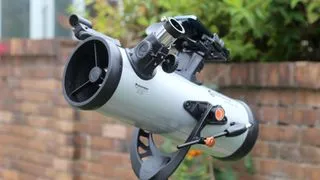 Celestron StarSense Explorer LT 114AZ reflector amateur astronomy telescope pointing at the sky against a brick wall backdropReflector telescopes are excellent for low-magnification targets such as galaxies and nebulas, making them great for deep-sky amateur astronomy.
Celestron StarSense Explorer LT 114AZ reflector amateur astronomy telescope pointing at the sky against a brick wall backdropReflector telescopes are excellent for low-magnification targets such as galaxies and nebulas, making them great for deep-sky amateur astronomy.
How a Catadioptric Telescope Works for Amateur Astronomy
Ideal for astrophotography, the catadioptric is an excellent instrument for taking a wide range of astronomical targets and is manufactured in order to take the best parts of two kinds of telescopes: The reflector and the refractor. What’s more, the catadioptric takes advantage of a lightweight design, meaning that it’s much more portable than other kinds of telescopes and its sealed optics promote little to no maintenance, advantages for an amateur astronomy telescope. The only major downside to choosing a catadioptric is that the vast majority can be expensive. However, if you are on a strict budget, picking up one of these instruments isn’t unheard of — you’ve just got to make sure to shop around for your amateur astronomy telescope.
While refractors use lenses, and reflectors make use of mirrors, to create and magnify an image, the catadioptric makes use of both lenses and mirrors for high-definition and superior views. During your observations, light from your chosen target passes through to a lens, which corrects or reduces aberration that distorts the view that is later taken in through the eyepiece. Curved primary mirrors then reflect this light onto a secondary mirror, which then reaches your eyes. You will find two kinds of Catadioptric telescopes for amateur astronomy — the Schmidt-Cassegrain and the Maksutov-Cassegrain.
The Maksutov-Cassegrain, also affectionately known as the ‘Mak’, corrects the optical problem that is experienced by reflectors — an aberration effect called ‘coma,’ which can make objects look distorted and appear like they have a tail. This effect is reduced or banished with the combined efforts of a spherical mirror and a meniscus lens, the latter of which is ‘weakly negative’. The Maksutov is also adept at correcting for chromatic aberration, or color fringing, a distortion that creates an unwanted purple or blue edging around bright night-sky objects, a common issue for other types of amateur astronomy telescope.
Packed into its short optical tube is a system that allows you to target higher magnification objects such as the planets, moon and double stars. Additionally, if you struggle to find objects and your way around the night sky, then both this type of catadioptric telescope and the Schmidt-Cassegrain can be found in abundance and equipped with a GoTo system, making them easier to use as an amateur astronomy telescope — but cost more.
The other most common kind of catadioptric, the Schmidt-Cassegrain, offers similar capabilities to the Maksutov and will allow you to make general observations of planetary targets and stars for amateur astronomy. It is also possible to expand the telescope’s field of view with the help of corrector lenses, enabling exquisite views of an even wider selection of astronomical targets.
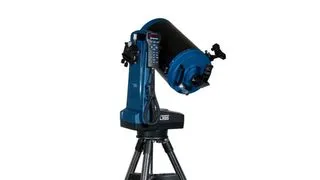 Product photo of Meade Instruments LX65 GoTo catadioptric amateur astronomy telescopeThe short optical tube allows high power magnifications in smaller packages, characteristic of a catadioptric amateur astronomy telescope.
Product photo of Meade Instruments LX65 GoTo catadioptric amateur astronomy telescopeThe short optical tube allows high power magnifications in smaller packages, characteristic of a catadioptric amateur astronomy telescope.
What is a Finderscope on an Amateur Astronomy Telescope?
A finder scope is a low-power (low magnification) telescope that sits on your main telescope, to help you track down your desired subject. Your main amateur astronomy telescope will typically have a narrow field of view, meaning you’ll see only a little portion of the sky when you look through it. Your finder scope, with a wider field of view, assists you in pointing your telescope, making it easy to hone in on your target with minimal searching and repositioning.
Center your subject in the finder scope’s frame; there are usually crosshairs or a dot so you know when it’s central. Now when you look through your telescope’s eyepiece, your subject will be centered here too.
Many amateur astronomy telescopes include a finder scope with the package. But if you need to purchase one separately, it’s important to know that there are two main types. One has a straight-through view, and one has a right-angled view. If you have a Newtonian reflector telescope you’ll want a right-angle finder. And if you use a refractor or catadioptric due to the location of their eyepieces you should buy a finder with a straight-through view. Some finder scopes will also be magnified — higher magnification and a narrower field may be desirable if you need pinpoint accuracy for your amateur astronomy telescope.
You’ll also come across the terms ‘inverted’ or ‘erect image.’ The latter means the finder scope has a correcting prism that flips the image the ‘right way up’ (top-to-bottom) and ‘around’ (left-to-right). Some finder scopes don’t have a correcting prism, so you see either a back-to-front image or upside down. This can be disorientating and make finding subjects more difficult, especially if you’re just starting out with your amateur astronomy telescope and wondering why your telescope’s controls seem to be inverted.
 Celestron Starsense explorer 8-inch dobsonian red dot finderscope attached to an amateur astronomy telescopeA finderscope attached to an amateur astronomy telescope may look like this. Pictured is the Celestron Starsense explorer 8-inch dobsonian red dot finderscope.
Celestron Starsense explorer 8-inch dobsonian red dot finderscope attached to an amateur astronomy telescopeA finderscope attached to an amateur astronomy telescope may look like this. Pictured is the Celestron Starsense explorer 8-inch dobsonian red dot finderscope.
Understanding Aperture, Magnification, and Focal Length on an Amateur Astronomy Telescope
Time to dispel jargon myths with a bit of an amateur astronomy telescope glossary. The larger a telescope’s aperture (the size of its main lens or primary mirror) the more light is collected and more fine detail is revealed. For example, a 200 mm aperture collects four times more light than a 100 mm telescope. Under ideal conditions, a 100 mm telescope reveals stars down to magnitude +11.8, while a 200 mm telescope will show stars down to magnitude +13.3. A 100 mm telescope will ‘split’ a double star separated by 1.5 arcseconds and resolves a three-kilometer lunar crater; however, a 200 mm telescope resolves a crater just 1.5 km across and a double star separated by just 0.6 arcseconds. Resolution is limited by the amateur astronomy telescope’s optical quality and the steadiness of the Earth’s atmosphere.
Telescopic magnification depends on the amateur astronomy telescope’s focal length (the distance between the objective lens/primary mirror and the point of focus of the light it collects) and the focal length of the eyepiece used. Magnification is calculated by dividing the telescope’s focal length by the eyepiece’s focal length. For example, a 1000 mm focal length telescope (say, a 100 mm refractor of f/10, or a 200 mm Newtonian of f/5) used in conjunction with an eyepiece of 10 mm will deliver a magnification of 80 times (800 divided by 10).
With any amateur astronomy telescope, the range of useful magnification depends on a telescope’s aperture and focal length, combined with the focal length of the eyepiece. Too low a magnification (taking in as wide an area as possible) will actually waste light since the ‘exit pupil’ of the eyepiece will be larger than the diameter of the pupil of your dark-adapted eye. On average, the adult pupil will dilate to around 7 mm in dark conditions. Therefore the exit pupil delivered by an eyepiece ideally needs to be 7 mm or smaller so that all the light gathered by the amateur astronomy telescope — especially when attempting to see faint objects — can be taken in. Exit pupil can be calculated by dividing the telescope’s aperture by the magnification delivered by any particular eyepiece.
How Telescope Eyepieces Work for Amateur Astronomy Magnification
Eyepieces work by magnifying the light focused by the amateur astronomy telescope‘s primary mirror or objective lens. Every telescope eyepiece has a specific focal length (given in millimeters), and the shorter this figure is, the higher the magnification. To calculate the magnification provided by any particular eyepiece on any telescope, divide the telescope’s focal length by the focal length of the eyepiece used. For example, a 1000 mm focal length telescope (say, a 100 mm refractor of f/10, or a 200 mm Newtonian of f/5) will deliver a magnification of 100 with a 10 mm eyepiece (1000 divided by 10 = 100).
Although any amateur astronomy telescope can give impressively high magnifications using short focal length eyepieces, there is a point when increasing magnification will provide a worse image rather than improve it. When an object is magnified, its brightness is reduced as the finite amount of light is spread over a larger area. In addition, increasing magnification exacerbates the amount of atmospheric turbulence visible; therefore, high magnifications can only be used when seeing conditions are good. Finally, high magnification is practical only with driven telescopes. Otherwise, the object will quickly drift out of the field of view when using an amateur astronomy telescope.
As a guide, your highest power eyepiece should deliver a magnification double the telescope’s aperture in millimeters — for example, 200x on a 100 mm telescope, 400x on a 200 mm telescope, and so on.
It’s best to have at least three good quality eyepieces that deliver low, medium and high magnifications for your amateur astronomy telescope — say around 50x, 100x and 200x. Taking as an example a 100 mm f/10 telescope, those eyepieces would be of 20 mm, 10 mm and 5 mm focal length. Let’s assume that these particular eyepieces are of the commonly used Plossl variety. A field of view around one degree across (an area of 0.8 square degrees) is given by the 20 mm eyepiece — ideal for sweeping the deep skies and finding objects. The 10 mm eyepiece will just take in the half-degree diameter moon and have a field covering just one-quarter that of the 20 mm eyepiece. With its high magnification, the 5 mm eyepiece has a field of view covering just one-sixteenth that of the 20 mm eyepiece and can only be used when seeing conditions allow with your amateur astronomy telescope.
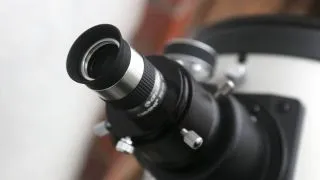 Celestron Starsense explorer 8-inch dobsonian close up view of amateur astronomy telescope eyepieceTelescope eyepieces can be changed to adjust the magnification of an amateur astronomy telescope. Pictured is the eyepiece from the Celestron Starsense explorer 8-inch dobsonian.
Celestron Starsense explorer 8-inch dobsonian close up view of amateur astronomy telescope eyepieceTelescope eyepieces can be changed to adjust the magnification of an amateur astronomy telescope. Pictured is the eyepiece from the Celestron Starsense explorer 8-inch dobsonian.
How We Test and Review Amateur Astronomy Telescopes
To guarantee you are getting honest reviews and informed recommendations of the best amateur astronomy telescopes, each telescope is thoroughly tested and used for observation to see how it performs in all aspects.
By looking at the build of the Optical Tube Assembly (OTA) we can give a clear breakdown to our readers. This includes discussing the type of telescope (refractor, reflector, catadioptric), how many parts the OTA consists of, the size of the OTA and the clarity of the lens. This is important because some amateur astronomy telescopes require advanced collimation (alignment) of the mirrors and consistent cleaning to make sure that they perform at their best.
Amateur astronomy telescope accessories, like eyepieces and mounts, are assessed in terms of their functionality and quality. Alt-azimuth and equatorial mounts are tested in terms of smooth movement, especially if they are motorized. Star alignment is another important feature we test, as it can range from aligning a finder scope to advanced laser collimation techniques required for some amateur astronomy telescopes.
Considering that telescopes are complicated optical instruments, we think about how much astronomical knowledge a user would need to operate the amateur astronomy telescope with ease. Powerful intricate telescopes often require regular collimation and movement can misalign the mirrors meaning that they require adjustment before every observation. Our recommendations also include whether we think the amateur astronomy telescope is portable and suitable for traveling to dark-sky sites.
The most important part of testing an amateur astronomy telescope is seeing how powerful its observational abilities are. We give examples of what we were trying to observe and say how good the image was, with honesty. With a range of telescopes, our reviewers have observed the moon, Jupiter and a range of Messier objects, checking for a range of aberrations and distortions in the image.
To give you a review you can trust, we test the claims of the telescope manufacturers against their real-life use. Our staff and freelance reviewers are seasoned stargazers with many years of experience using amateur astronomy telescopes. We also work with astronomy experts to ensure that we are giving you the most accurate and important information on telescope use for amateur astronomy.
Choosing the right amateur astronomy telescope is your first step towards unlocking the incredible beauty of the night sky. Whether you’re a complete beginner or looking to upgrade, the options reviewed here offer pathways to unforgettable celestial views. Armed with the knowledge from this guide, you’re ready to select the perfect amateur astronomy telescope and begin your journey into the wonders of the cosmos. Happy stargazing!

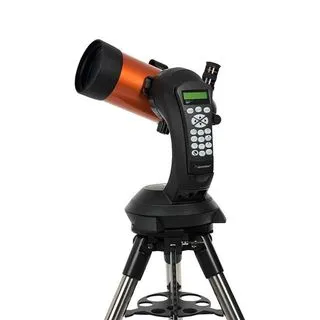 Celestron NexStar 4SE beginner amateur astronomy telescope on a white backgroundCelestron NexStar 4SE
Celestron NexStar 4SE beginner amateur astronomy telescope on a white backgroundCelestron NexStar 4SE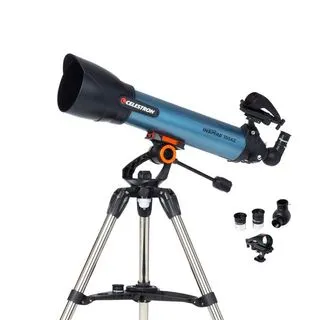 Celestron Inspire 100AZ budget amateur astronomy telescope on a white backgroundCelestron Inspire 100AZ
Celestron Inspire 100AZ budget amateur astronomy telescope on a white backgroundCelestron Inspire 100AZ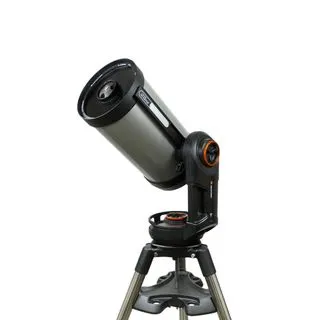 Celestron NexStar Evolution 9.25 premium amateur astronomy telescope on a white backgroundCelestron NexStar Evolution 9.25
Celestron NexStar Evolution 9.25 premium amateur astronomy telescope on a white backgroundCelestron NexStar Evolution 9.25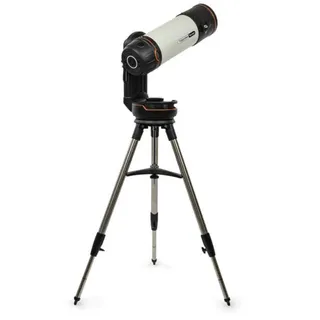 Celestron Origin for astro amateur astronomy telescope on a tripod on a white backgroundCelestron Origin Intelligent Home Observatory
Celestron Origin for astro amateur astronomy telescope on a tripod on a white backgroundCelestron Origin Intelligent Home Observatory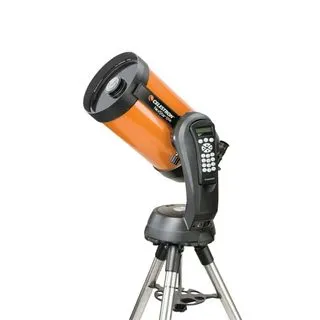 Celestron NexStar 8SE motorized amateur astronomy telescope on a white backgroundCelestron NexStar 8SE
Celestron NexStar 8SE motorized amateur astronomy telescope on a white backgroundCelestron NexStar 8SE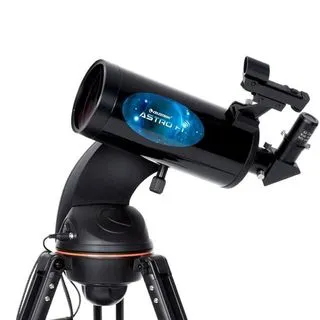 Celestron Astro Fi 102 portable amateur astronomy telescope on a white backgroundCelestron Astro Fi 102
Celestron Astro Fi 102 portable amateur astronomy telescope on a white backgroundCelestron Astro Fi 102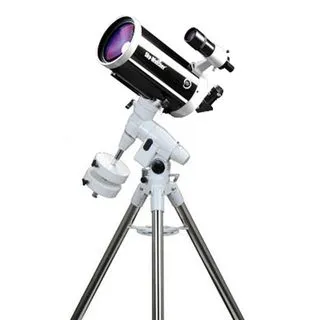 Sky-Watcher Skymax 150 PRO amateur astronomy telescope on a white background with accessoriesSky-Watcher Skymax 150 PRO
Sky-Watcher Skymax 150 PRO amateur astronomy telescope on a white background with accessoriesSky-Watcher Skymax 150 PRO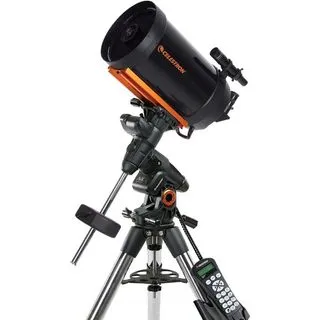 Celestron Advanced VX 8 EdgeHD Schmidt-Cassegrain Amateur Astronomy TelescopeCelestron Advanced VX 8 EdgeHD
Celestron Advanced VX 8 EdgeHD Schmidt-Cassegrain Amateur Astronomy TelescopeCelestron Advanced VX 8 EdgeHD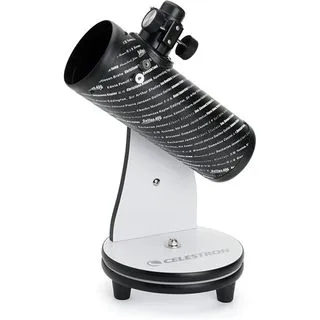 Celestron Classic Firstscope 76mm Tabletop Amateur Astronomy TelescopeCelestron FirstScope 76 Tabletop telescope
Celestron Classic Firstscope 76mm Tabletop Amateur Astronomy TelescopeCelestron FirstScope 76 Tabletop telescope